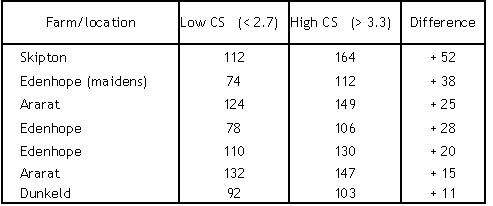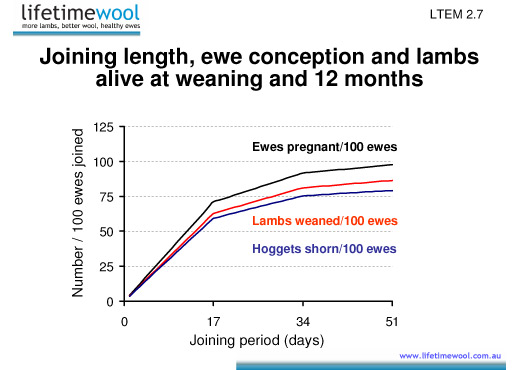|
This section covers these
topics; 
The
impact of
ewe condition on
reproductive rate
Ewes in higher Condition
Score (CS) at joining
conceive more lambs and
therefore have a higher
reproductive rate (measured
as foetuses/100 ewes
joined).
Ovulation rate at joining is
largely determined by ewe
condition at joining.
The condition of a ewe
on the day of joining
is a more reliable predictor
of reproductive rate than
changes in condition prior
to joining. Ewes should be
in CS 3+ at day 17 of
joining (end of the first
cycle).
The reproductive rate
increases with increasing
ewe CS. It is linear between
CS 1.5 and 4.5. The average
response is about 20 extra
lambs per 100 ewes for an
additional CS at joining.
The response in ewe
reproductive rate to
increased ewe CS at joining
outlined in LTEM 2.1, is
much greater than previous
extension programs have
promoted.

The higher
reproductive rate is due to
fewer dry ewes and more ewes
conceiving twins.
1. At
CS 3, there should be no
more than 10% dry ewes in
most Merino flocks and less
than 5% dry ewes in
cross-bred flocks.
2. In
flocks scanning around 150%,
more than 50% of ewes carry
twins and less than 5% will
be dry.

Back to
Top
The
variable responses in
reproductive rate between
flocks and the
potential lambing
The response in reproductive
rate (foetuses/100 ewes
joined) varies for different
flocks. The key factors
affecting the responsiveness
of flocks are their genetics
and time of lambing. In the
lambing flocks studied the
later lambing were more
responsive.
It is critical to understand
the responsiveness of your
flock's reproductive rate
(foetus/100 ewes joined) to
increased ewe condition at
joining. Knowing your
flock's response is
important in making
decisions about feeding ewes
leading up to joining.
Whether your ewe flock is
responsive (+30 lambs/CS) or
less responsive (+10
lambs/CS) to improving CS at
joining, can affect the
profitability of ewe
management options
approaching joining by $1 to
$3 per ewe, depending on the
value of extra lambs.
Establishing the link between
ewe CS at joining and
subsequent lambing
performance for your flock
will help with future
management decisions. The
flocks involved in the
lifetimewool demonstration
phase tagged 50 high CS (CS
3 and above) and 50 low CS
(CS 2.7 and below) and
scanned the ewes for 0, 1 or
2 foetuses.
The results in LTEM 2.5 show
that the extra foetuses
scanned varied from 13-60%.
This highlights the need to
determine the responsiveness
of your own flock. The
lifetimewool on-farm
demonstration sites in 2005
had an average response of
about 24 extra foetuses
scanned for each additional
CS at joining. Calculating
the Reproductive Rate
LTEM 2.5
Farmer case studies -
ewe condition score at
joining and scanning
performance

Length
of Joining
Joining duration is the number
of days that ewes are exposed to
rams. Ewes cycle every 17 days.
It is recommended that joining
duration for flocks lambing in
winter/spring be no longer than
34 days (2 cycles). Ewes
joined in prior to January
1st should be teased
(14days) prior to joining
with rams for 34 days.
Extended joining periods
(>34 days) typically
results in less than 10%
more ewes conceiving and
produce only 2-4% more lambs
that reach 12 months of age.
This is due to the poor rate
of survival to 12 months of
age for late born lambs.
(LTEM 2.7)

Back to
Top
|